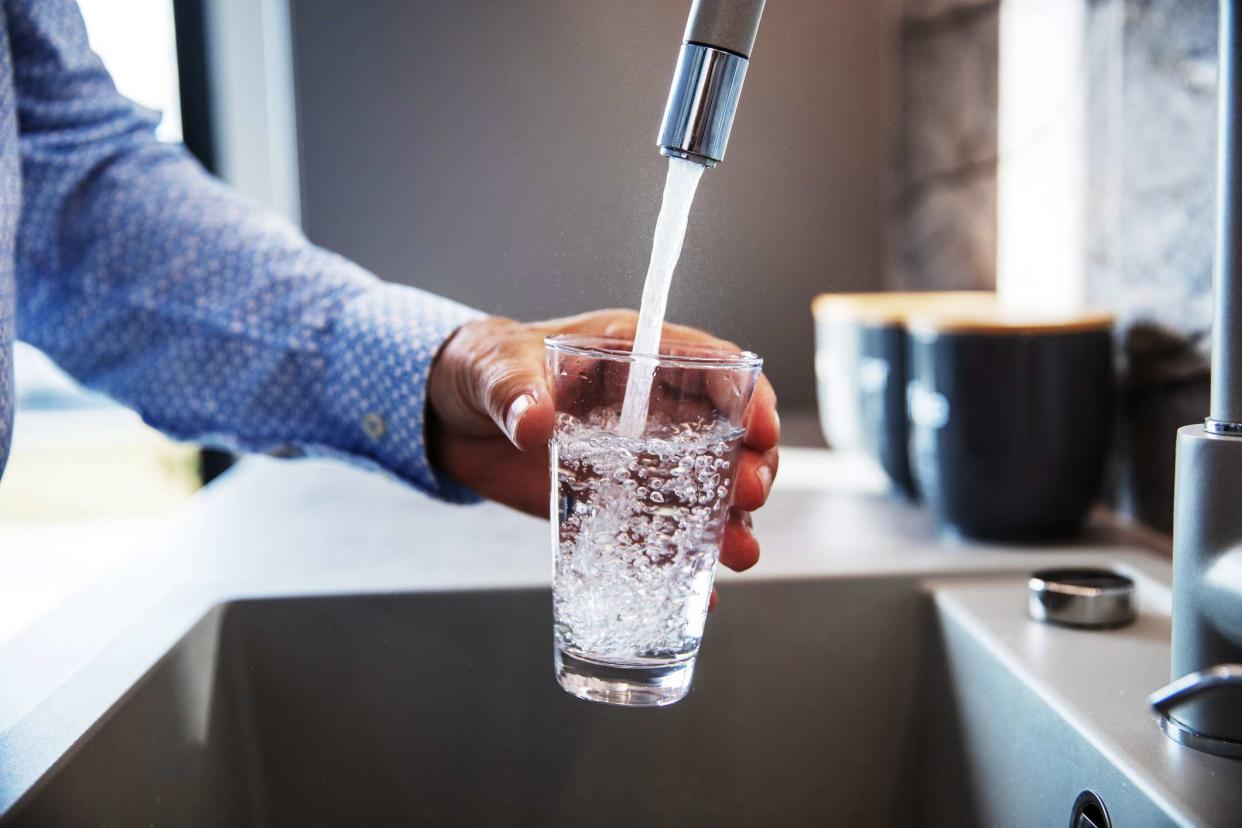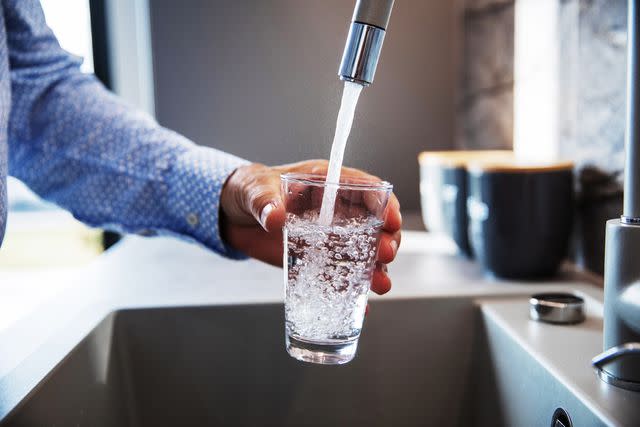Extreme Heat Can Be Deadly, Experts Urge These Tips for Avoiding Illness and Injury

Getty Images / vitapix
Fact checked by Nick Blackmer
July 1 recorded the most hospitalizations for heat-related illnesses in one day.
Temperatures have continued to remain high throughout the United States, with certain regions (like the Southwest and Southeast) at higher risk of heat-related illness than others.
Experts recommend remaining indoors as much as possible and prioritizing hydration.
Extreme heat can be deadly, and temperatures in the United States give experts reason for concern.
This has been a record-setting summer for heat in the U.S. In fact, according to a global temperature analysis from NASA, June 2023 was the hottest June on record.
The National Oceanic and Atmospheric Administration (NOAA) indicated that about 5,000 heat and rainfall records have been broken in the U.S. in the last 30 days, Joe Alton, MD, a physician, medical preparedness advocate, and author of “The Survival Medicine Handbook: The Essential Guide For When Help Is NOT On The Way” told Health.
The hot weather is not without consequences. An analysis by the Centers for Disease Control and Prevention (CDC) indicates that the number of emergency room visits for heat-related illness has been higher than in the past five years.
“Hospitals have certainly seen a notable increase in the number of patients showing symptoms of heat-related illnesses, particularly in the Southwest and South Florida, compared to regions like the Northeast,” Naval Parikh, MD, a board-certified internist and chief of medicine of Broward Health North in Florida told Health.
“But it is difficult to assess the exact number of patients admitted solely for heat-related illnesses, as some symptoms can mimic other diseases [and not be reported as such],” he said.
The CDC currently reports that the highest number of hospitalizations for heat-related illnesses in one day was 3,467 on July 1, which is very much an outlier from prior years, said Isabel M. Algaze Gonzalez, MD, assistant clinical professor of emergency medicine, University of California, Irvine School of Medicine.

Getty Images / vitapix
Extreme Heat Puts Everyone at Risk
Extreme heat in the U.S. is dangerous for everyone. But older people, outdoor workers, children, overweight individuals, and those with certain underlying medical conditions are at greater risk for injury or death, Lori Solomon, MD, MPH, the chair and clinical associate professor of family and community medicine at New York Medical College told Health.
Solomon explained that intense heat increases the heart's workload, making people with heart conditions at higher risk for complications. She also added people on medications for blood pressure, anyone on diuretics (water pills), and people with diabetes to the list of people who are at a higher risk in the heat.
When temperatures get extremely high, people of any age have a greater likelihood of experiencing heat-related illnesses that can lead to cardiovascular and respiratory issues, heat stroke, and other complications. These illnesses can even lead to death.
Last year, nearly 62,000 people died in one of the hottest summers on record in Europe. Researchers found that the extreme heat impacted older people and women more than other demographics.
In the United States, the CDC reported a yearly average of 702 deaths due to heat-related illness.
It also doesn’t help that heat waves typically come on suddenly, not giving people’s bodies time to adjust.
“Even for people who have grown up in the Valley of the Sun, it takes about two weeks for your body to become acclimated to summer heat,” said Erik Mattison, MD, medical director of the emergency department at Dignity Health Chandler Regional Medical Center in Arizona.
He pointed out that one of the trickiest symptoms to overlook is dehydration, which can quickly lead to a variety of medical problems.
Falls can also be dangerous, Mattison said.
In states like Arizona, New Mexico, Texas, Oklahoma, Louisiana, and Florida, the temperatures are so high, that within minutes of contact with concrete or asphalt, people can start to sustain first and second-degree burns. They also can get contact burns from hot seatbelts, metal surfaces, and more.
Staying Safe in Intense Heat
According to Mattison, staying safe starts with hydration.
“It’s not enough to gulp a bottle of water on the way out the door,” he said. “Start pre-hydrating at least the day before any sort of activity.”
It also can be helpful to limit the number of sodas and caffeinated drinks you consume because those will dehydrate you.
“And if you are starting to feel thirsty, you’re already behind the eight ball in a sense because your body is telling you that your volume is depleted,” Mattison said. “You’re already in danger of heat exhaustion.”
He also advised moving any outdoor activities to the early hours of the morning, or indoors to avoid the heat. If you have to be outside during peak heat hours, plan accordingly.
“Wear light, loose clothing along with a hat or other head covering,” Mattison said. “If you start to feel lightheaded, it’s likely you’re already experiencing heat exhaustion and it’s time to cool off. Get out of the heat, get cool water on you, and drink water.”
If you are out in the sun, make sure you also are wearing sunscreen John Schumann, MD, the executive medical director at Oak Street Health in Oklahoma said.
He explained that sunburns negatively impact your body’s ability to regulate temperature.
“When this happens, the body diverts fluid from the rest of the body toward the burn in an effort to heal the damaged area, he said. “This diversion means you have less water available for sweating, which can make it harder for your body to stay comfortable.”
Keep in mind, too, that your normal body temperature is around 98.6 degrees Fahrenheit, said Parikh, so when the outside environment exceeds this temperature, your body will struggle to dissipate the heat thru sweating.
“[To stay safe]. pay attention to your body and know your risk factors for dehydration, such as the use of certain medications that have an impact on how you retain water,” said Mattison. “That is really important, especially in heat like this.”
How Much Water Should You Drink?
In normal conditions, some health experts advise that you drink 11.5 cups of fluid per day if you are a woman and 15.5 cups per day if you are a man. But in the heat, you may need more water.
“You really have to drink about eight ounces of water every 15 minutes, or a liter every hour, just to keep up with normal losses,” Mattison said.
Keep in mind, a lot of people are already a bit dehydrated on an average day, so sweating is only going to exacerbate that, Schumann said.
“We often lose electrolytes during the sweating process as well, which can leave us feeling depleted after a few hours in the sun,” he said. “So it’s important to increase your water intake.”
Gonzalez suggests that people also replace electrolytes with Pedialyte or another similar electrolyte drink.
Tips From the National Park Service
According to the National Park Service, the best way to stay safe and avoid heat-related illnesses while exploring includes:
Packing plenty of water and salty snacks
Drinking water regularly or eating hydrating foods like cucumbers and watermelon
Eating salty snacks
Resting in the shade on a frequent basis
Splashing water on yourself to cool down
Wearing lightweight, light-colored clothing
Putting on sunscreen
Scheduling activities before 10 a.m. or after 4 p.m.
Turning back if it feels too hot
Calling for help if you or someone you are with experiences a heat-related illness
How to Quickly Cool Down Your Body
If you find yourself overheating in these record-breaking temperatures, it’s important to know how to quickly cool your body down.
According to Mattison, the quickest way to do that is through evaporative cooling.
“Get a fan on you and use misting bottles,” he said. “You also could run a cool bath or jump into a pool. Then try to rest in a cooler place and continue to drink water.”
Other options for cooling down include pouring water over your head and clothing, said Parikh.
“Another way to cool off is to place your hands and feet in cool water, or use cold packs in areas where blood vessels run closely to the skin like the armpits, neck, and groin,” Alton said.
Even putting an ice cube on your wrist or neck could accelerate that cooling process, said Schumann. “Those are key areas where blood vessels are already anatomically close to the surface of the skin, and even closer when they are dilated.”
Related: Heat Exhaustion Symptoms You Should Never Ignore
When to See a Healthcare Provider
Symptoms of heat exhaustion or heat stroke can represent a medical emergency that requires rapid intervention, said Alton. Warning signs include:
Profuse sweating
Rapid pulse
Hot, red, or dry skin
Muscle cramps
High body temperature
Nausea and vomiting
Headache, dizziness, or confusion
Feeling tired or weak
Fainting or passing out
“If a person experiencing heat exhaustion is refusing water, they need medical attention, as their condition could easily escalate to heat stroke,” said Mattison.
Heat stroke is life-threatening and requires immediate medical attention. If a person is suffering from any heat stroke symptoms, call 911 or go straight to your local emergency room.
Alton explained that heat stroke may include shortness of breath, loss of consciousness, and seizures.
“The body also loses the ability to sweat as a way to dissipate heat, leading to dry, hot, bright red skin,” he said. “This represents blood vessels desperately trying to cool the body down. Fatal shock and organ malfunction may be the end result.”
Related: What Are Heat Cramps?
For more Health news, make sure to sign up for our newsletter!
Read the original article on Health.

